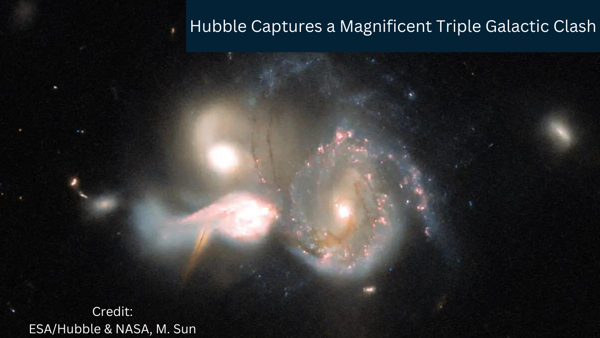
Science & Space
Hubble Captures The Universe's Most Rare Event : Spectacular Triple Galactic Crash
The Hubble Space Telescope was launched on April 24, 1990, to explore the universe in detail. Using the ground telescope had some difficulties and constraints because the ground telescope has its own limitations due to the effect of earth variables that affect the observation from land, light pollution, and variable weather patterns are the primary causes of problems for observation.
With these issues in mind, scientists set out on a mission to explore the universe and various galactic events without encountering any earthly difficulties.
Since its launch, it opened pandora's box of the universal events from which the scientists were isolated. It aided scientists in observing baby galaxies, various types of exoplanets, and nebulae, and most importantly, it introduced the world to the concept of dark matter, which accounts for 95% of the universe and is also responsible for dark energy.
Aside from the events mentioned above, it also introduced the world to the concept of galaxy clash, which is rare among the rarest events in the galactic arena.
In 2021, the Hubble space telescope captures two galaxies on the verge of colliding, and the European Space Agency shares a picture of their proximity to each other before the collision. "Clash of Titans" was the name given to the event.
But, the Hubble Space Telescope recently captured a previously unseen event: the spectacular triple galactic clash on February 12, 2023.
The spectacular event is taking place in the Boötes constellation, 870 light years from our solar system from the primary end and 430 years from the secondary end. These galaxies are set on a collision course and will eventually merge into a bigger galaxy giving birth to newer solar systems, stars, and various kinds of exoplanets.
Astronomers refer to this colliding trio as "SDSSCGB 10189". Each of the galaxies is within 50,000 light-years of each other, which appears to be a comfortable distance, but in the case of measuring the distance between galaxies, they are only neighbors of each other, and these two neighbors will eventually be merged into one single galaxy.
These galaxies have been categorized by scientists and astronomers as Brightest Cluster Galaxies to examine the prominent and useful galaxies in a most detailed way.
The observation technique was primarily intended to assist scientists and astronomers in determining the origin of the universe's most massive and bright galaxies. Astronomers believe that the Brightest Cluster Galaxies are formed by the merger of large, gas-rich galaxies like the ones, which is happening right now in the Boötes constellation in the event of "SDSSCGB 10189".
The scientists and astronomers used Hubble's Wide Field Camera 3 and Advanced Camera for Surveys to study this galactic trio in great detail, hoping to shed light on how the Universe's most massive galaxies are being formed.
One galactic collision has been predicted for our own Milky Way galaxy. In about 4.5 billion years, the Milky Way will collide with the Andromeda galaxy. According to scientists, the earth may not be there to see because the sun will devour its inner planets because the sun will be reached the end of its age and will die eventually.
When a galactic collision occurs, the entire scenario becomes chaotic due to the devastating and mind-boggling energy released by the collision of objects within the system. It will eventually give birth to a new stable galaxy in the future, but due to our age constraint, we will not live that long.

0 Comments